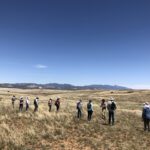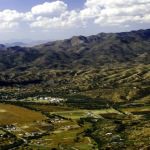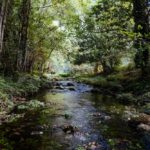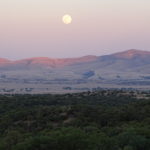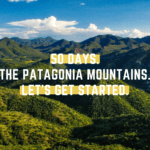Sep 15, 2016 | Blog
By Jenny Neeley, Attorney at Law
Introduction: National Environmental Policy Act & Scoping Process
The National Environmental Policy Act (NEPA) requires all federal agencies to prepare a “detailed statement” on the impacts of any proposed action that may “significantly affect the quality of the human environment.”¹ This “detailed statement” can take one of two forms:
- Environmental Assessment (EA), a brief analysis used to determine the significance of impacts resulting from a federal action, or
- Environmental Impact Statement (EIS), a detailed and thorough analysis used for those actions that are expected to result in significant impacts.
Federal agencies are required to go through a public “scoping process” in order to determine the scope of issues that should be addressed in an EA or EIS. Scoping also helps the agency determine the likely significance of an action’s impacts, and whether an EA or an EIS will be required.
What to Include in NEPA Scoping Comments
The scoping period is the best time to identify all the issues and resources that the agency must consider when preparing an EA or EIS, as well as the potential impacts the proposed action may have on those resources.
Identify resources likely to be impacted.
This includes all the resources and values that are likely to be impacted by the proposed action, including:
- Air quality
- Water quality and quantity
- Wildlife and vegetation, including endangered, threatened, and other special status species
- Wildlife movement corridors
- Soils
- Watersheds Floodplains, wetlands, and riparian areas
- Cultural and Archeological resources
- Visual resources and scenic values
- Dark skies
- Recreation
- Transportation and traffic
- Public safety
- Socioeconomic Impacts
Identify potential impacts resulting from proposed action.
The scoping period is also the best time to identify all the potential impacts that are likely to result from the proposed action. The potential impacts will vary depending on the specific activity being proposed, and can include ecological, aesthetic, historic, cultural, economic, social, and health related impacts. When assessing potential impacts, the agency must look at:
- Direct impacts: “are caused by the action and occur at the same time and place;”
- Indirect impacts: “are caused by the action and are later in time or farther removed in distance, but are still reasonably foreseeable (e.g., induced changes in land use patterns, population density, and related effects on natural resources and ecosystems);” and
- Cumulative impacts: “the impact on the environment which results from the incremental impact of the action when added to other past, present, and reasonably foreseeable future actions, regardless of what agency or person undertakes such actions. Cumulative impacts can result from individually minor but collectively significant actions taking place over a period of time.” ²
REMEMBER: You don’t have to do the analysis for the agency. At the scoping stage, you just need to identify the issues and potential impacts that must be analyzed. You should also submit any research or supporting documentation that is relevant to assessing the significance of the project’s potential impacts. The agency is obligated to consider this material when drafting the EA or EIS.
Act Now: Hermosa-Taylor Deposit Drilling Project Scoping Notice and Plan of Operation.
———————————–
1 National Environmental Policy Act (NEPA), 42 USC § 4332(C) (1982).
2 Council for Environmental Quality, NEPA Implementing Regulations, 40 CFR § 1508.8 (2010).

Jan 13, 2015 | Blog
FOR IMMEDIATE RELEASE
Plug Pulled on Proposed “Sunnyside” project in Arizona’s Coronado National Forest
Tucson, Ariz. — Today the U.S. Forest Service temporarily put the brakes on an environmentally hazardous mining project in southern Arizona’s Coronado National Forest that it previously approved in August. The Forest Service’s decision follows a similar move by the U.S. Fish and Wildlife Service, which had originally given the project the green light in August and then withdrew its approval in December. The agency decisions to withdraw their approvals of the Canadian mining company Regal Resources’ “Sunnyside Project” are based on the project’s potential violation of multiple environmental laws.

photo by Nathan Rupert
“The agencies knew from the beginning that this project could have a devastating impact on the local wildlife and habitat in this unique corner of the country,” said Rob Peters of Defenders of Wildlife. “The Coronado is home to an incredible diversity of imperiled species like the jaguar, ocelot and yellow-billed cuckoo, all which are already at risk from multiple projects in the region.”
“No one understood why they approved this project to begin with, but for the sake of Patagonia’s residents and wildlife, we are glad to see that they’ve reconsidered,” added Peters.
In October conservation groups Defenders of Wildlife and the Patagonia Area Resource Alliance filed a lawsuit claiming the federal agencies’ approvals the Sunnyside project violated environmental laws and posed a threat to endangered species and the safety of drinking water for local residents.
“Sunnyside could have been a disaster not only for our region’s unique wildlife, but also for the residents living directly downstream and the municipal watershed of the town of Patagonia,” said Wendy Russell of the Patagonia Area Resource Alliance. “Projects like Sunnyside use and abuse a tremendous amount of the local water supply and create long-term destruction of wildlife habitat. The people and wildlife of our national forests deserve more, and the agencies know that.”
Click to hear from environmental attorneys on why they sue.
###
Contact: Courtney Sexton, csexton@defenders.org, 202-772-0253
Wendy Russell, wendy@patagoniaalliance.org, 520-477-2308
Defenders of Wildlife is dedicated to the protection of all native animals and plants in their natural communities. With more than 1.1 million members and activists, Defenders of Wildlife is a leading advocate for innovative solutions to safeguard our wildlife heritage for generations to come. For more information, visit www.defenders.org and follow us on Twitter @DefendersNews.
The Patagonia Area Resource Alliance is a citizen watchdog organization that monitors the activities of mining companies, as well as ensures government agencies’ due diligence, to make sure their actions have long-term, sustainable benefits to our public lands, our water, and the town of Patagonia. For more information visit www.patagoniaalliance.org and follow us on Twitter @PARAalliance.

Oct 29, 2014 | Blog
FOR IMMEDIATE RELEASE
October 29, 2014
Contact: Courtney Sexton, csexton@defenders.org, 202-772-0253
Wendy Russell, wendy@patagoniaalliance.org, 520-477-2308
Groups file complaint against Forest Service and Fish and Wildlife Service for approval of mineral drilling project in Arizona’s Coronado National Forest
TUCSON, ARIZ. – Defenders of Wildlife and the Patagonia Area Resource Alliance today asked a federal court to hold the United States Forest Service and United States Fish and Wildlife Service accountable for their unlawful approval of the “Sunnyside” mineral exploration drilling project in southern Arizona’s Coronado National Forest, in the Alum Gulch area of the Patagonia Mountains. The groups say the approval of the Canadian mining company Regal Resources’ Sunnyside Project violates environmental laws and poses a potential threat to endangered species and the safety of drinking water for local residents. The Sunnyside Project involves drilling multiple exploratory holes up to 6,500 feet deep in one of the most biologically diverse mountain ranges in Arizona. The extensive drilling and construction would run 24/7 for months on end, and the total project operations could last up to 3 years.

Mexican spotted owl, ©Gooch Goodwin
The Coronado National Forest, the Patagonia Mountains and the watersheds in this region support some of the world’s most imperiled wildlife, including the jaguar, ocelot, lesser long-nosed bat, Mexican spotted owl, and yellow-billed cuckoo. Of particular concern is the Mexican spotted owl “Protected Activity Center” (PAC) in the Alum Gulch area, a site which is supposed to have the greatest protection of the law. One of the project’s proposed drilling sites is only one-tenth of a mile from the “nesting core area” of this PAC.
“The potential damage from the Sunnyside Project, especially coupled with other damaging mining projects in the region, could have devastating impacts on this imperiled wildlife and the habitat they depend on, as well as the water supply for local residents,” said Rob Peters of Defenders of Wildlife. “This is a national forest and imperiled wildlife and their habitats on the forest should be protected— not polluted by expanded drilling operations.”

Ocelot, Leopardus pardalis. photo US FWS
Patagonia area residents are dependent on water originating from Alum Gulch, an area which is also designated as critical habitat for the jaguar and Mexican spotted owl. The imperiled ocelot, lesser long-nosed bat, and yellow-billed cuckoo have also been observed near the project area.
“The Sunnyside Project could have tremendous adverse impacts on local wildlife and local residents, affecting the floodplains and the municipal watershed of the town of Patagonia,” said Wendy Russell of the Patagonia Area Resource Alliance. “The drilling will require 12,500 gallons of water per day, an amount approximately equal to ten percent of the daily water usage of the Town of Patagonia. This project threatens not only endangered wildlife, but our community’s water, health and safety.”
Click to hear from environmental attorneys on why they sue.
###
Defenders of Wildlife is dedicated to the protection of all native animals and plants in their natural communities. With more than 1.1 million members and activists, Defenders of Wildlife is a leading advocate for innovative solutions to safeguard our wildlife heritage for generations to come. For more information, visit www.defenders.org and follow us on Twitter @DefendersNews.
The Patagonia Area Resource Alliance is a citizen watchdog organization that monitors the activities of mining companies, as well as ensures government agencies’ due diligence, to make sure their actions have long-term, sustainable benefits to our public lands, our water, and the town of Patagonia. For more information visit www.patagoniaalliance.org and follow us on Twitter @PARAalliance.
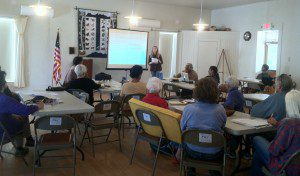
Mar 27, 2014 | Blog
PARA, Jenny Neeley and Sergio Avila from Sky Island Alliance teamed up again to host a NEPA comment workshop at Cady Hall in Patagonia on March 26, 2014. Discussed were the potential issues of the Forest Service’s Draft Environmental Assessment of the AZ Mining Inc / Wildcat Silver / Arizona Minerals Hermosa mining exploration proposal and how to comment effectively on it.
 Jenny Neeley reprised her role as our National Environmental Policy Act (NEPA) expert for tips on filing public comments on the Hermosa draft Environmental Assessment (EA) released by the Coronado National Forest. The purpose of an Environmental Assessment is to determine whether the impacts of a project will be significant. The goal for our comments on the draft EA is to demonstrate that the Hermosa project impacts will be significant so that the Forest Service conducts a more detailed and comprehensive Environmental Impact Statement. Read more tips for writing comments here.
Jenny Neeley reprised her role as our National Environmental Policy Act (NEPA) expert for tips on filing public comments on the Hermosa draft Environmental Assessment (EA) released by the Coronado National Forest. The purpose of an Environmental Assessment is to determine whether the impacts of a project will be significant. The goal for our comments on the draft EA is to demonstrate that the Hermosa project impacts will be significant so that the Forest Service conducts a more detailed and comprehensive Environmental Impact Statement. Read more tips for writing comments here.
PARA board member Cliff Hirsch gave a summary of the expected activities proposed by the AZ Mining Inc / Wildcat Silver / Arizona Minerals Hermosa exploratory drilling project located 6 miles southeast of the Town of Patagonia. The project activities encompasses 7350 acres of both Coronado National Forest and private land. It is also expected to use 3,525,800 gallons of groundwater pumped from within the Town of Patagonia Municipal Supply Watershed. Click here for talking points and Hermosa project summary.
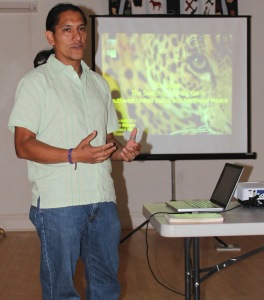
SIA Biologist, Sergio Avila
SIA biologist Sergio Avila discussed the amazing biodiversity found in the Patagonia Mountains during the Bioblitz event conducted in April 2013. View the Bioblitz report here. The results from the Bioblitz and the ongoing wildlife tracking in the Patagonia Mountains demonstrate the importance of the Patagonias as a wildlife corridor and biological hotspot in the sky island mountain ranges of southern Arizona and northern Mexico. Click for a list of Federally Threatened, Endangered and Sensitive Species in the Patagonia Mountains of the Coronado National Forest in southern Arizona.
The Hermosa draft Environmental Assessment is available at the Patagonia Public Library and online at the Forest Service website on the Hermosa project page: http://www.fs.fed.us/nepa/nepa_project_exp.php?project=41158.
Thank you everyone for your participation. The Forest Service received 200 public scoping comments on the Hermosa Plan of Operation. Let’s send them 200 more on the draft EA! Deadline to submit comments is Friday, April 11, 2014.
Additional Resources:
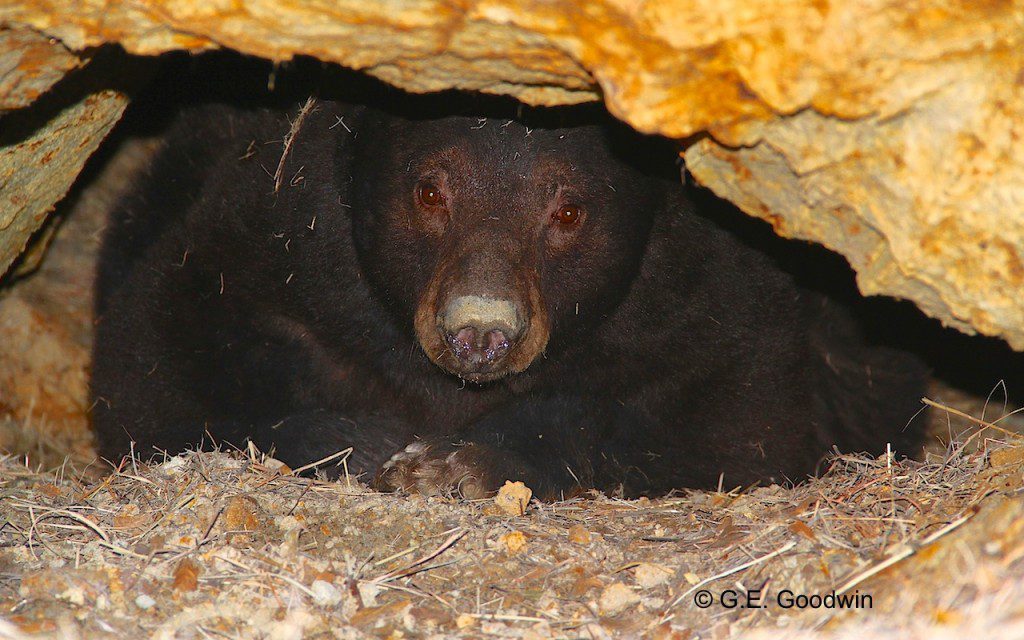
Save my home in the Patagonia Mountains. ©Gooch Goodwin
Mar 27, 2014 | Blog
Tips for Writing Comments for a Draft EA
By Jenny Neeley
1. Consider whether the effects significant. If they are, then the Forest Service must prepare a more detailed Environmental Impact Statement (EIS) rather than an Environmental Assessment (EA). When deciding whether the impacts are “significant” NEPA implementing regulations (40 CFR § 1508.27) require that agencies consider both:
- Context: The significance of an action must be analyzed in several contexts such as society as a whole, the affected region, the affected interests, and the locality. Significance varies with the setting of the proposed action. For instance, in the case of a site-specific action, significance would usually depend upon the effects in the locale rather than in the world as a whole. Both short- and long-term effects are relevant.
- Intensity: This refers to the severity of impact. …The following should be considered in evaluating intensity:
- Impacts that may be both beneficial and adverse. A significant effect may exist even if the Federal agency believes that on balance the effect will be beneficial.
- The degree to which the proposed action affects public health or safety.
- Unique characteristics of the geographic area such as proximity to historic or cultural resources, park lands, prime farmlands, wetlands, wild and scenic rivers, or ecologically critical areas.
- The degree to which the effects on the quality of the human environment are likely to be highly controversial.
- The degree to which the possible effects on the human environment are highly uncertain or involve unique or unknown risks.
- The degree to which the action may establish a precedent for future actions with significant effects or represents a decision in principle about a future consideration.
- Whether the action is related to other actions with individually insignificant but cumulatively significant impacts. Significance exists if it is reasonable to anticipate a cumulatively significant impact on the environment. Significance cannot be avoided by terming an action temporary or by breaking it down into small component parts.
- The degree to which the action may adversely affect districts, sites, highways, structures, or objects listed in or eligible for listing in the National Register of Historic Places or may cause loss or destruction of significant scientific, cultural, or historical resources.
- The degree to which the action may adversely affect an endangered or threatened species or its habitat that has been determined to be critical under the Endangered Species Act of 1973.
- Whether the action threatens a violation of Federal, State, or local law or requirements imposed for the protection of the environment.
2. Make your comments “substantive” and specific. The Forest Service is required by law to respond to all “substantive” comments submitted during the public comment period; the more specific and focused your comments are, the more detailed the response must be from the agency. Comments that simply say “I am opposed to this project” will not, by themselves, require a response from the agency.
3. Include the specific sections, pages and/or topics you are referencing in the Draft EA. To the extent you can, direct your comments to specific sections, pages or topics in the Draft EA, recognizing that some comments may be addressing missing or incomplete information, or even missing topics, that you feel should be addressed.
4. Make your letter personal! Your personal connection to the Patagonia Mountains and surrounding area is an incredibly important part of your comment letter. You should explain how will you be personally impacted if this proposal moves forward. Include information about how it will affect your home, your land, your family, and/or your business and livelihood. This is a great way to start your letter and to frame the rest of your comments, and will help get the Forest Service’s attention.
Additional Information
See our NEPA Resources page: http://www.patagoniaalliance.org/nepa-resources/
More information about Wildcat Silver at: http://www.patagoniaalliance.org/wildcat-silver/
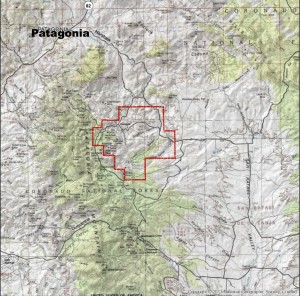
Mar 18, 2014 | Blog
The Coronado National Forest has released the draft Environmental Assessment (EA) for the AZ Mining Inc (aka Wildcat Silver, Arizona Minerals Inc) Hermosa exploratory mineral drilling project in the Patagonia Mountains.
Assist PARA in protecting our precious and imperiled natural resources such as clean water and wildlife, and actively advocate for the preservation of those resources by opposing AZ Mining Inc / Wildcat Silver’s draft EA drilling exploration plan.
- Plan to attend and ask questions at the public meeting hosted by the Coronado National Forest about AZ Mining Inc / Wildcat Silver’s draft Environmental Assessment at the Patagonia Union High School. Monday, March 24 from 6-8pm.
- Submit comments to the Forest Service about AZ Mining Inc / Wildcat Silver’s draft EA drilling plan. Want to know how? Attend PARA’s comment-writing workshop with Jenny Neeley and Sergio Avila on Wednesday, March 26, 4pm – 7pm Open House at Cady Hall.
- Sign a petition telling the Coronado National Forest that an EA is insufficient and a full Environmental Impact Statement is necessary when considering the Hermosa mineral drilling proposal. Sign Petition here.
- Advocate for the protection of our community’s drinking water, natural resources, and distinct, serene rural way-of-life by making a donation. Every single donation assists PARA in our watchdog efforts for the Patagonia area.
Deadline to comment is Monday, April 7, 2014. The Hermosa draft EA is available online at the Forest Service project webpage:http://www.fs.fed.us/nepa/nepa_project_exp.php?project=41158.

Hermosa Drilling Proposal Location
To submit your comments:
Include your name, postal address, title of the project (Hermosa Drilling Project) and signature (or verification of identity upon request.)
Comments may be submitted as follows:
Email: Electronic comments including attachments may be submitted by email in word (.doc), rich text format (.rtf), text (.txt), portable document format (.pdf), and hypertext markup language (.html) to: comments-southwestern-coronado@fs.fed.us with subject: Hermosa Drilling Project.
Facsimile: 520-388-8305, ATTN: Margie DeRose
U.S. Mail: Coronado National Forest, ATTN: Margie DeRose, 300 W. Congress St., Tucson, AZ 85701
Hand-delivery: 6th floor, 300 W. Congress St., Tucson, AZ 85701. Monday through Friday, 8 a.m. to 4:30 p.m., excluding Federal holidays.
Only individuals who submit comments about this proposed project during this public comment period will be eligible to file an objection.
Exposing New Threats
While AZ Mining Inc / Wildcat Silver’s draft EA drilling exploration is up for public review and comment,
the plans that AZ Mining Inc / Wildcat Silver is sharing with investors are for an open pit silver mine in the Patagonia Mountains with the details revealed in a document found on their website:
“Form 43-101F1 Technical Report Pre-Feasibility Study.”
AZ Mining Inc / Wildcat Silver’s Pre-Feasibility Study contains a wide range of information about the open pit mine they want to dig in the Patagonia Mountains. PARA and Earthworks are coordinating to analyze AZ Mining Inc / Wildcat Silver’s pre-feasibility study so that the community can fully understand the impacts of the proposed open pit mine.
Earthworks is a national non-profit organization based in Washington D.C. that is “dedicated to protecting communities and the environment from the impacts of irresponsible mineral and energy development while seeking sustainable solutions. Earthworks stands for clean water, healthy communities and corporate accountability.”
PARA has teamed with Earthworks to develop an independent, peer-reviewed report of the potential consequences of AZ Mining Inc / Wildcat Silver’s open pit mine on our groundwater, the potential for acid drainage contamination, heavy metals pollution, as well as the range of issues associated with air pollution, light and noise pollution.
By teaming with Earthworks and commissioning this report, the dangers of mining in the Patagonia Mountains can no longer be dismissed as opinion, but will present a meaningful and credible analysis highlighting specific and anticipated impacts from the proposed AZ Mining Inc / Wildcat Silver open pit mine.
We are fortunate to have a group of amazing and committed community members and generous donors supporting our work that make everything we do for the Patagonia area possible.
Please consider a gift today to ensure that we have the scientific analyses necessary to actively challenge the Hermosa proposal and AZ Mining Inc / Wildcat Silver’s web of obfuscation. You may contribute securely online at: www.patagoniaalliance.org/donations. Also, please consider a recurring monthly contribution through PayPal.
Every single contribution makes a sizable difference in our organization and ultimately for the community of Patagonia. It is only because of the generous support from people like you that we can undertake this critical work. Thank you!
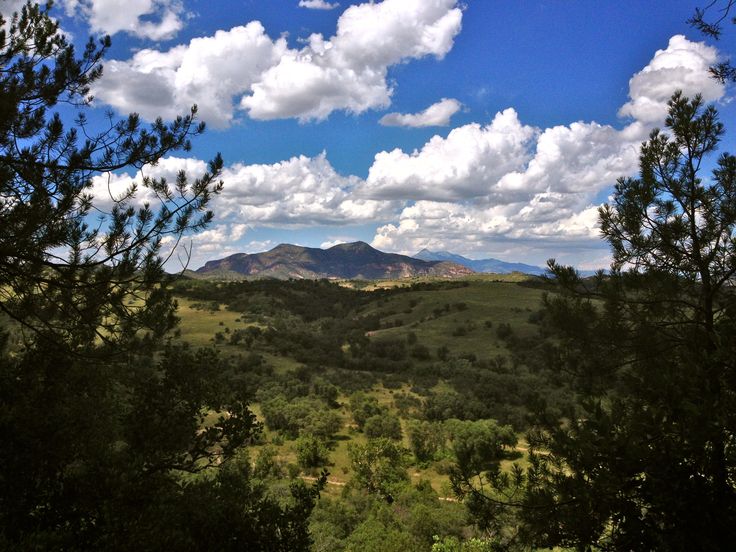
One site of Hermosa Mineral Drilling Proposal: Corral Canyon in the Patagonia Mountains.
Aug 22, 2013 | Blog
By Jenny Neeley, Conservation Policy Director & Legal Counsel of Sky Island Alliance
Introduction: National Environmental Policy Act & Scoping Process
The National Environmental Policy Act (NEPA) requires all federal agencies to prepare a “detailed statement” on the impacts of any proposed action that may “significantly affect the quality of the human environment.”¹ This “detailed statement” can take one of two forms:
- Environmental Assessment (EA), a brief analysis used to determine the significance of impacts resulting from a federal action, or
- Environmental Impact Statement (EIS), a detailed and thorough analysis used for those actions that are expected to result in significant impacts.
Federal agencies are required to go through a public “scoping process” in order to determine the scope of issues that should be addressed in an EA or EIS. Scoping also helps the agency determine the likely significance of an action’s impacts, and whether an EA or an EIS will be required.
What to Include in NEPA Scoping Comments
The scoping period is the best time to identify all the issues and resources that the agency must consider when preparing an EA or EIS, as well as the potential impacts the proposed action may have on those resources.
Identify resources likely to be impacted.
This includes all the resources and values that are likely to be impacted by the proposed action, including:
- Air quality
- Water quality and quantity
- Wildlife and vegetation, including endangered, threatened, and other special status species
- Wildlife movement corridors
- Soils
- Watersheds Floodplains, wetlands, and riparian areas
- Cultural and Archeological resources
- Visual resources and scenic values
- Dark skies
- Recreation
- Transportation and traffic
- Public safety
- Socioeconomic Impacts
Identify potential impacts resulting from proposed action.
The scoping period is also the best time to identify all the potential impacts that are likely to result from the proposed action. The potential impacts will vary depending on the specific activity being proposed, and can include ecological, aesthetic, historic, cultural, economic, social, and health related impacts. When assessing potential impacts, the agency must look at:
- Direct impacts: “are caused by the action and occur at the same time and place;”
- Indirect impacts: “are caused by the action and are later in time or farther removed in distance, but are still reasonably foreseeable (e.g., induced changes in land use patterns, population density, and related effects on natural resources and ecosystems);” and
- Cumulative impacts: “the impact on the environment which results from the incremental impact of the action when added to other past, present, and reasonably foreseeable future actions, regardless of what agency or person undertakes such actions. Cumulative impacts can result from individually minor but collectively significant actions taking place over a period of time.” ²
REMEMBER: You don’t have to do the analysis for the agency. At the scoping stage, you just need to identify the issues and potential impacts that must be analyzed. You should also submit any research or supporting documentation that is relevant to assessing the significance of the project’s potential impacts. The agency is obligated to consider this material when drafting the EA or EIS.
Take Action: Write Comments for Hermosa Mining Proposal by Arizona Minerals / Wildcat Silver: http://www.patagoniaalliance.org/take-action-hermosa-mining-proposal-arizona-minerals-wildcat-silver/
———————————–
1 National Environmental Policy Act (NEPA), 42 USC § 4332(C) (1982).
2 Council for Environmental Quality, NEPA Implementing Regulations, 40 CFR § 1508.8 (2010).
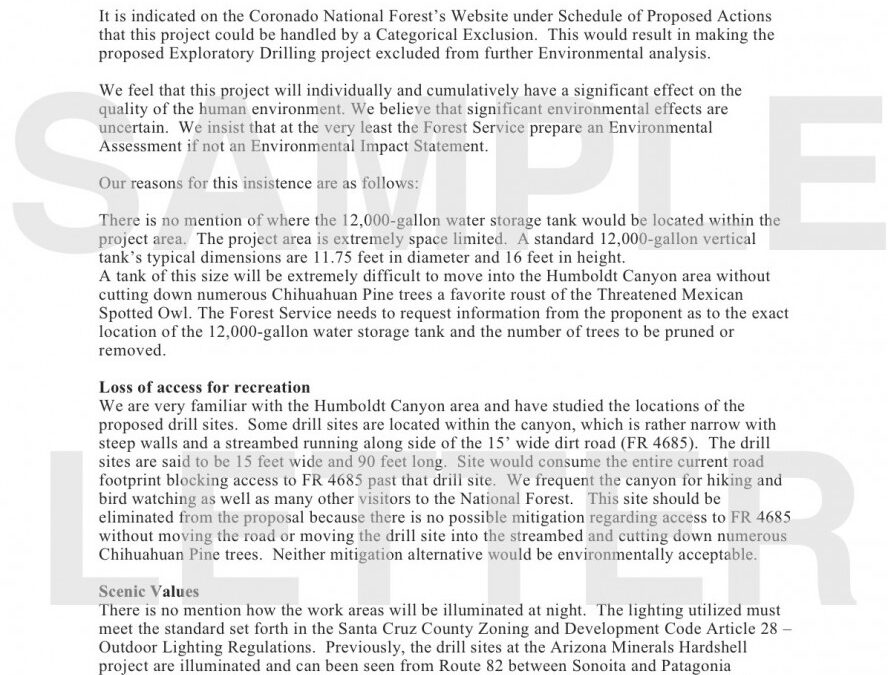
Aug 9, 2013 | Blog
By Jenny Neeley, Conservation Policy Director & Legal Counsel of Sky Island Alliance
Introduction
The National Environmental Policy Act (NEPA) requires federal agencies to go through a public “scoping process” in order to determining the scope of issues to be addressed in an environmental assessment (EA) or environmental impact statement (EIS). To start the process, the agency must issue a Notice of Intent and invite public input on the scope of issues to be examined. The US Forest Service is required to go through a public scoping process for all proposed actions, including those that the Forest proposes to categorically exclude from NEPA analysis.
When agencies give proposed projects a “categorical exclusion” from NEPA, the agency is not required to take a close look at the environmental impacts of the project. Below is more information on how the public can engage in the scoping process and make the case that the project should not be categorically excluded, but should instead be subject to an EA or an EIS under NEPA.
What is a Categorical Exclusion?
A categorical exclusion (referred to as ‘CE’ or ‘Cat Ex’) is a category of actions established by each individual agency that are exempted from the NEPA requirements to prepare an EA or EIS because they are considered to not have a significant effect on the human environment, either individually or cumulatively.¹ A proposed action may be categorically excluded from preparing an EIS or EA only if it fits into one of these categories and “if there are no extraordinary circumstances related to the proposed action.”
Challenging Categorical Exclusions in Scoping Comments
There are four steps to writing effective comments that challenge the use of categorical exclusions:
1. Check the mining plan to make sure the proposed action fits into the categorical exclusion for mineral exploration activities: “Short-term (1 year or less) mineral, energy, or geophysical investigations and their incidental support activities that may require cross-country travel by vehicles and equipment, construction of less than 1 mile of low standard road, or use and minor repair of existing roads.”² If the proposed action does not meet these parameters, then it cannot be excluded from NEPA.
2. Determine whether there are any “extraordinary circumstances” that relate to this proposed action: Resource conditions that are considered in determining whether extraordinary circumstances exist are:
- Federally listed threatened or endangered species or designated critical habitat, species proposed for Federal listing or proposed critical habitat, or Forest Service sensitive species; View list for Patagonia Mountain area.
- Flood plains, wetlands, or municipal watersheds;
- Congressionally designated areas, such as wilderness, wilderness study areas, or national recreation areas;
- Inventoried roadless areas or potential wilderness areas;
- Research natural areas;
- American Indians and Alaska Native religious or cultural sites, and
- Archaeological sites, or historic properties or areas.³
3. If one or more of the above resource conditions exist in the project area, you must demonstrate that:
- There is a cause-and-effect relationship between a proposed action and the potential effect on the resource conditions considered “extraordinary circumstances,” and
- The degree of potential effect on those resources – including cumulative effects – raises uncertainty over whether those effects are significant. If you can raise this uncertainty about the significance of potential impacts, you can make a good case for precluding the use of a categorical exclusion.
4. Show that the impacts of all past, present, and reasonably foreseeable future actions in the project area raise uncertainty about the significance of the “cumulative impacts” of this project. The Forest is required to examine the impacts of all past, present, and reasonably foreseeable future actions in the project area, regardless of what agency or entity is undertaking those actions, and determine the potential for cumulative impacts. When a project is proposed to receive a cat ex, you can make the case for preparing an EA by raising uncertainty over the significance of these effects.
Asking for an EA and Identifying Scope of Issues
After making the case that a categorical exclusion is inappropriate, don’t forget to also identify the scope of issues you think should be addressed in the EA you are asking the agency to prepare. It is important submit comments identifying the full range of resources and issues that may be impacted by the proposed action. These resources and issues generally include:
- Water quality
- Water quantity
- Air quality
- Soils
- Vegetation and wildlife
- Threatened and endangered species
- Wildlife corridors/wildlife movement
- Cultural resources
- Visual resources and scenic values
- Dark Skies
- Recreation
- Public safety
- Transportation
- Socioeconomic Impacts
- Cumulative Impacts
Remember: you don’t have to do the analysis for them. At the scoping stage, you just need to identify the issues they must analyze. You should also submit any research or supporting documentation that is relevant to assessing the impacts of this project on the identified resources. The agency is obligated to consider this material in its assessment.
Other online resources:
PARA NEPA Resources page
USFS NEPA Handbook: Categorical Exclusions
Citizen’s Guide to NEPA
Challenging Categorical Exclusions in Scoping Comments: Letter Template
[Date]
[Address]
[Re: Project name]
Open your letter with something personal describing why you care about this place: “I am a resident of Patagonia;” “I often visit the Patagonia Mountains for recreation/employment/tourism;” “I own a property in the area;” etc.
This project should not qualify for a categorical exclusion from NEPA. a) Extraordinary circumstances in the project area raise uncertainty about the project’s impacts; and b) The potential for cumulative impacts raise uncertainty about the project’s impacts. (See above for more information on how to make this argument effectively.)
The agency [Forest Service] should prepare an environmental assessment to analyze the impacts of this project on all the resources in the project area. (See above for sample list of resources and issues to identify.)
August 15, 2013 public comment deadline for Regal Resources Sunnyside mining exploration proposal.
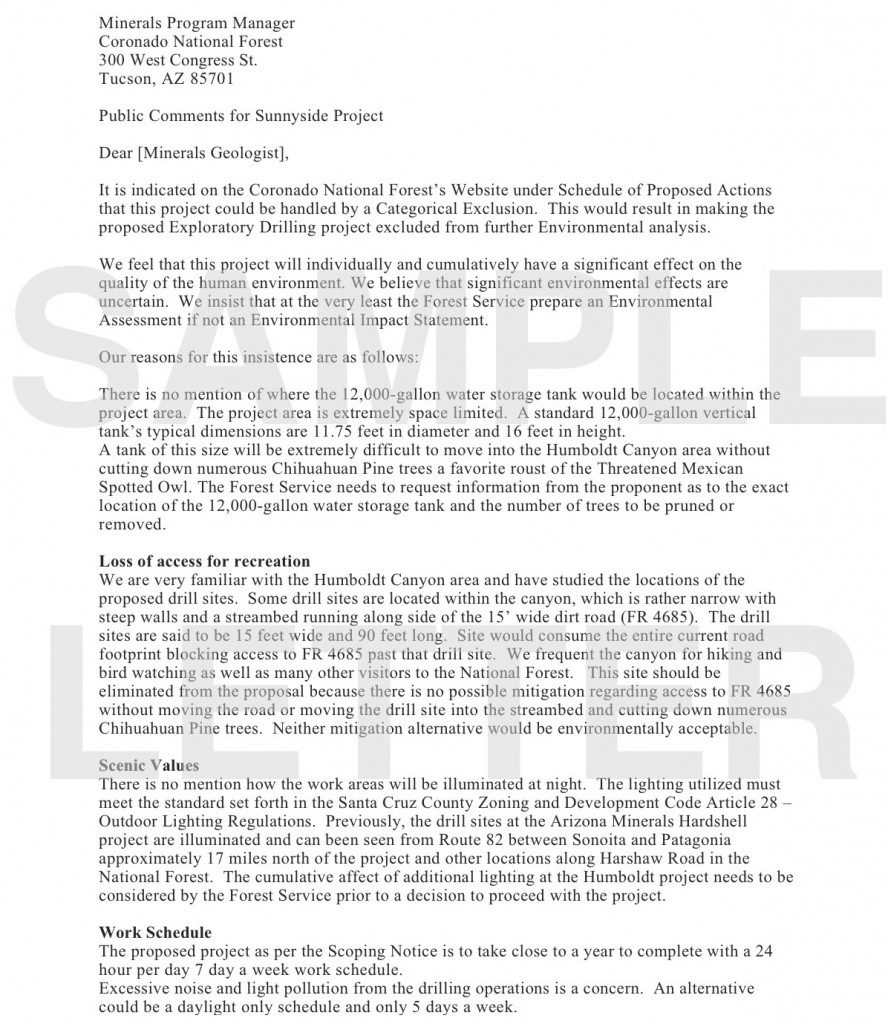
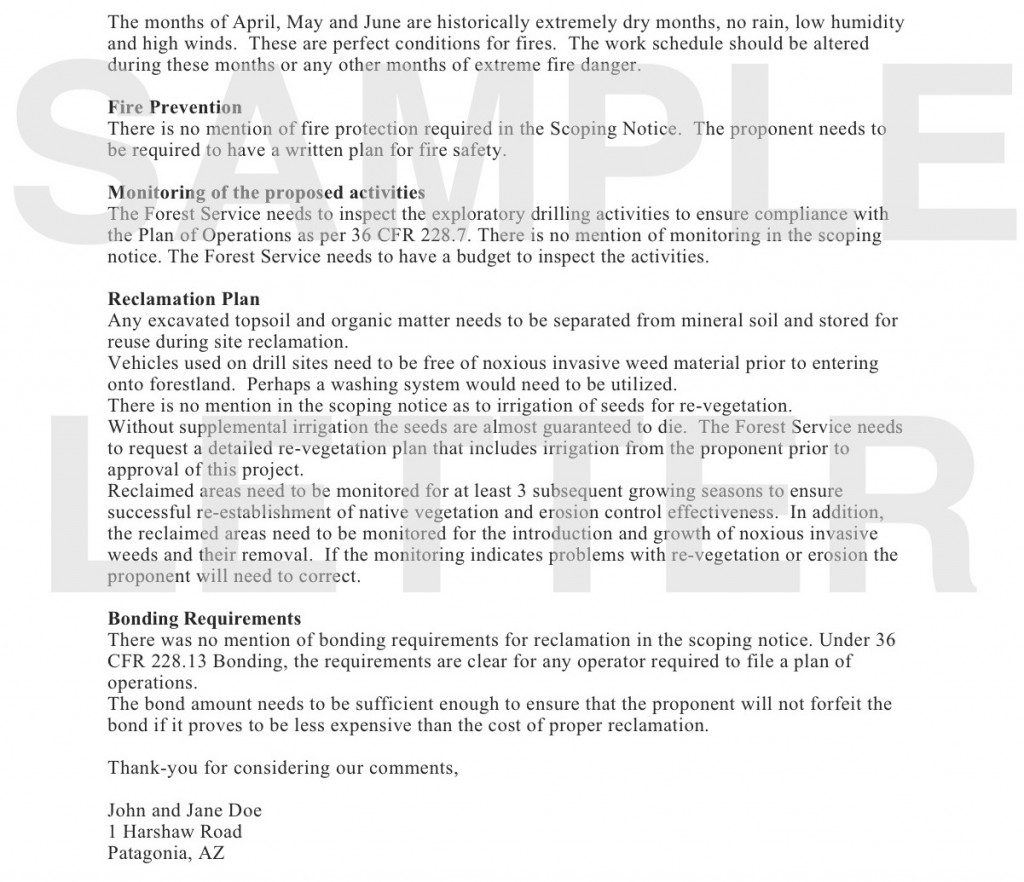
———————-
1. Council for Environmental Quality (CEQ) Regulations for Implementing the National Environmental Policy Act (40 CFR 1508.4). Available at nepa.gov/ceq_regulations/regulations.html
2. USFS NEPA Handbook; FSH 1909.15; 36 CFR 220.6(e)(8)). Available online at http://www.patagoniaalliance.org/wp-content/uploads/2013/08/US-Forest-Service-NEPA-Handbook_Categorical-Exclusion-regs.pdf
3. USFS NEPA Handbook, FSH 1909.15; 36 CFR 220.6(b). Available online at http://www.patagoniaalliance.org/wp-content/uploads/2013/08/US-Forest-Service-NEPA-Handbook_Categorical-Exclusion-regs.pdf
Jun 25, 2012 | Blog
Dear Ms. Bush,
The Patagonia Area Resource Alliance was horribly disappointed with your editorial for Tucson KOLD News, “Time to end fight, start mining”.
We don’t consider actions of the opposition to the proposed Rosemont Mine as fighting. This mine would have a permanent impact on the area’s water supply, ecosystem, landscape and residents. We, the public, are entitled to a thorough analysis of the potential impacts of the proposed mine as accorded to us by the National Environmental Policy Act. When governing agencies fail to follow the rules as dictated by NEPA, lawsuits are often the only tool available to get compliance. Public lands belong to everyone, and we have a legal right to a transparent and thorough review of projects proposed on our public land. Don’t deny us our due process.
Arizona was traditionally a mining state, but mining has been replaced by the tourism, aerospace, and micro-electronics industries as our top revenue producers. Also consider that the revenue generated by mining is closely followed by that generated through agriculture/food production. Mining is no longer the primary driving economic force of Arizona. The Arizona Office of Tourism commissioned a ten year study that showed total direct travel spending in Arizona in 2008 was $18.5 billion with $1.4 billion in state and local tax revenues and $1.2 billion in federal tax revenues. These revenues are most important to rural areas like Sonoita. Can we afford to jeopardize our largest economic driver and greatest source of tax revenue?
Also note that a study commissioned by the Western Governors’ Association showed that outdoor recreation is a $646 billion national industry and in the Western States, it’s a $256 billion industry. Why not promote outdoor recreation in the Santa Rita Mountains? It’s sustainable; compatible with the current ranching and farming economy; and far less harmful to the water supply and ecology.
Arizona currently has enough operating copper mines to meet demand. These mines currently have hundreds of unfilled job openings implying that they are not even operating at full production. If current mines are unable to find sufficient workforce in Arizona, where is Rosemont Copper going to get their workers? The jobs they promise will have to be filled by an imported workforce. How does that benefit the unemployment rate in Arizona?
The Rosemont Mine has a projected life-span of approximately 20 years and will result in permanent damage to the Rosemont Valley and surrounding ecosystem. We need visionaries willing to look at the bigger picture and willing to move forward with what is going to benefit the most people for the longest period of time. The proposed Rosemont Mine does not fit that bill. Pushing it forward for the sake of short-term jobs denies the area of the much greater potential economic benefits of promoting industries such as ranching, food & wine production, outdoor recreation and tourism. We ask that you reconsider your position and promote a more sustainable and beneficial economic future for all Arizonans.
Sincerely,
Wendy Russell
Patagonia Area Resource Alliance
If you’d like to record a rebuttal to the KOLD editorial, e-mail Debbie Bush at dbush@TucsonNewsNow.com

May 12, 2012 | Blog

Masquerading as a bill about “strategic and critical minerals,” HR 4402 takes the nation’s top toxic polluter, the hardrock mining industry, and strips away key protections for public health, water and communities.
The current law that governs hardrock mining on public lands already allows for open access to mineral resources – for free. Under the 1872 Mining Law, gold, copper, silver and uranium are mined by multinational corporations without any return to the owner of the mineral, the taxpayer. Mining is also considered the “highest and best use” of public lands. As such, federal land managers cannot, and do not, deny mine proposals. In addition to the inadequacies of this antiquated law, the mining industry is also exempt from key provisions of some of our most important environmental laws, like the Clean Water Act.
HR 4402 makes the current environmental threats posed by hardrock mining worse. By truncating the permitting process and effectively eliminating meaningful environmental review, this legislation threatens water resources across the United States and limits the ability of mining-impacted communities to protect their land, water and health.
Mining at Any Cost
This bill allows federal agencies to exempt mining projects from review under the National Environmental Policy Act of 1969 (NEPA). NEPA makes sure that in addition to government and industry input, everyday citizens can take part in the development and oversight of projects that affect our social, economic, and environmental health.
This legislation would run roughshod over the values of transparency and public participation that are at the heart of NEPA, the process that has allowed us to find out one of the most disturbing statistics about the nature of hardrock mines: 75% of them end up polluting surrounding surface or groundwater, in spite of this environmental review.
HR 4402 caps the length of the permit process to just 30 months and allows regulators to exempt mining projects from the Equal Access to Justice Act (EAJA) as well. EAJA is legislation that makes nonprofit environmental law firms possible, which allows average Americans to protect their communities and families from pollution. Impacted communities often cannot afford lawyers, much less the litany of scientific and technical experts needed to mount a serious challenge to a multinational mining company.
A Better Way
Disenfranchising rural communities and polluting western waters is not a solution. In addition to research on recycling and alternative, sustainable sources for metals, 1872 Mining Law reform is needed to protect some of our most precious resources. HR 4402 takes us in the wrong direction. The hardrock mining industry should be clamoring to lead the world in better mining practices, not catering to the lowest common denominator.
Oppose this bill now!
http://www.earthworksaction.org/






 Jenny Neeley reprised her role as our National Environmental Policy Act (NEPA) expert for tips on filing public comments on the Hermosa draft Environmental Assessment (EA) released by the Coronado National Forest. The purpose of an Environmental Assessment is to determine whether the impacts of a project will be significant. The goal for our comments on the draft EA is to demonstrate that the Hermosa project impacts will be significant so that the Forest Service conducts a more detailed and comprehensive Environmental Impact Statement.
Jenny Neeley reprised her role as our National Environmental Policy Act (NEPA) expert for tips on filing public comments on the Hermosa draft Environmental Assessment (EA) released by the Coronado National Forest. The purpose of an Environmental Assessment is to determine whether the impacts of a project will be significant. The goal for our comments on the draft EA is to demonstrate that the Hermosa project impacts will be significant so that the Forest Service conducts a more detailed and comprehensive Environmental Impact Statement. 









